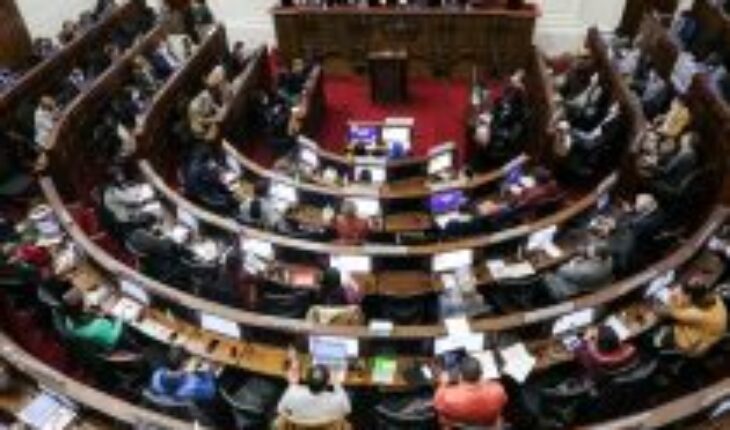Carl Schmitt, Hitler’s famous kronjurist, belatedly joined the Nazi Party. As biographers recount, his intellectual roots lie in minority Catholicism in Plettenberg, a rural village in the Protestant province of the Rhineland. There he grew up with a deep theological drive, being part of a small Catholic fraction. According to scholars, this marked his life, as it determined a “sense of foreignness”. In a context of rural Protestantism, the young Schmitt grew up near the local parish, as his father was the lay administrator of the parish. Their childhood friendships come from the same circle.
Schmitt was a Catholic
Decades later, when Nazism triumphed, Schmitt jumped from academia to the administration of the state, becoming one of the Führer’s orejeros. His fundamental writings, however, date from before hitler’s rise. One of his key texts is Roman Catholicism and Political Form, published in 1922, where the idea of a substantive connection between juridical forms and theological concepts emerges. The presence of intellectual Catholicism in the author is extremely intense, to the point of defining politics through Catholic forms. This is a decisive writing to understand the fanatical key of his texts. Already in his 1928 Theory of the Constitution, Schmitt makes it clear that the theological framework is the most abstract institutional reference architecture, which is reflected in the Fundamental Charter as a salvific project led by a leader. In 1932, his most famous essay appears, entitled The Concept of politics, where he points out that the fundamental distinction of the work of politics is between friends and enemies, confronted in the institutional field.
This intuition about existential denial among neighbors, taken to its extreme to the point of fanaticism, is what explains why Schmitt joined the Nazi Party in May 1933, fifty days after Hitler’s second electoral triumph. Exactly three months after the Reichstag fire, a false flag attack used by Nazi hierarchs to go on to rule by decree and state of emergency. The definitive step, his absolute genuflection, occurs in 1934, when he publishes the unusual text called The Führer defends the Law”. There, a metaphorical relationship is read between the figure of the Christian messiah and the leader of the eschatological project, that is, the one who offers a world to come, a new stage of humanity.
Schmitt’s singular thesis is key to understanding the Third Reich: sovereign is the one who decides on the state of exception; at that moment the friendship of some versus the enmity of others is crystallized. This is how the Fuehrer is sovereign, for in the state of emergency he targets the enemy of the people. That was precisely the institutional reasoning of Nazism. All his argumentative echelons can ultimately be referred to Schmitt.
The intellectual position of the author was then consolidated as an interpersonal influence. One of his biographers, the Mexican Héctor Orestes Aguilar, points out: “During the years of National Socialism it was hesitant to contradict Carl Schmitt: he could send one to a concentration camp.” Given this cloak of fear around his figure, when the regime fell, he was sent to Nuremberg, where he was not convicted. He returned to live his old age in Plettenberg, to pray in the same parish, without ever abjuring his “Nazi adventure”.
How much did his theological drive have to do with his “academic” theses? Beyond still: What is the connection between salvific Catholicism and eschatological politics? Could it not be that their fanaticism does not emanate directly from the events of 1933 onwards, but from a particular interpretation of Catholicism? Examples similar to Schmitt, that is, salvific-authoritarian thinkers, have permeated the last centuries. We can call them “theologians-politicians” and in that category place from the nineteenth-century Donoso Cortés, posthumous ideologue of Francoism, to Latin American thinkers of recent decades. For, despite being biographically linked to Nazism, Schmitt is an author widely cited by left-wingers devoted to liberation theology.
Thus, it is not surprising that in the Constitutional Convention constituents of theological inspiration are observed, formed in a particular reading of Schmitt and an unfathomable relationship with religion. Thus, for example, whoever was vice president and coordinator of the rules committee, has a past in the Legion.Aryans of Christ. She was also very close to Gonzalo Rojas Sánchez at the Catholic University. He stands out for authoritarian practices, false complaints in the ethics commission against his detractors and other slips. This is Amaya Álvez Marín, professor at the University of Concepción, PhD from the University of York in Canada.
Along with her, the former coordinator of the justice systems commission has a past as a seminarian, as he abandoned his priestly vocation halfway through. To get to the Convention, he got a quota with the Christian Democracy, and then left it at the altar with the excuse of being close to his “friends”. This is Cristián Viera Álvarez, professor at the Catholic University of Valparaíso, doctor from the University of Deusto, in the Basque Country.
At the helm of the clan, we can observe a nephew of Jaime Guzmán, a former DC militant, promoter of liberation theology, who stands out for obliquely endorsing the seizures, funas and persecutions against his critics. His political philosophy drinks directly from the dichotomies of friend/foe, good/bad, loyalty/disloyalty. Behind that, we can find a doctrine based on the refoundation of the Church, as he argues in one of his essays on liberation theology. This is Fernando Atria Lemaitre, professor of law at the University of Chile, doctor of law from the University of Edinburgh, in Scotland.
All very Schmittian.
The bench
Regarding Atria, there are dozens of references to Schmitt in his publications. However, it is his political practice, in relation to his theses, that makes it possible to explain his influence. This Schmittian caucus within the convention has certain key characteristics that refer to Schmitt’s texts. We can point out its ability to target an internal enemy of the institution, its intellectual vocation for dichotomy and the use of constituent commissions as adversarial spaces. At the same time, especially in Atria and Viera, his commitment to liberation theology is visible, with intense references to the Uruguayan priest Juan Luis Segundo. Viera himself points to the Institutional Church, as the victimizer of liberation theology, supposedly persecuted by Rome. Viera says of the liberationist experience:
What became of that experience? We know of the direct intervention of Rome to condemn this current as heterodox, provoking a purge of theologians who thought and taught from this perspective. The Catholic Church abandons the popular classes and turns in its discourse, moving from a sociological matrix to a pneumatological one. What characterizes this new account of the Church? An individualistic and deontological discourse, a determined presence in the elites and the favoring of new movements with a strong spiritualist tinge: Opus Dei, Legionaries, Schöenstatt. What became of liberation theology? By the way, preterida. (Viera, El Desconcierto, 2018).
It is clear, then, the true intellectual cleavage of Viera: the institutional Church with the powerful, such as Opus, versus the other Church which would not be individualistic, nor deontological, nor spiritualist. In a text by Atria, we can find a description of that “other” Church, which the author relates to the “oppressed creatures”. Regarding the crisis of the Church, Atria argues, quoting the Jesuit priest Costadoat:
It is too early to know how the current crisis will unfold, and what impact it will have on the institutional Church. Some of the resources that the Church might have had in the past to confront it are no longer available, partly as a consequence of the moralistic turn already mentioned. Costadoat says that the biggest problem with liberation theology is that it was running out of church (…) In my view, this is not just a problem for liberation theology. It is a problem for a Church that, by arrogating to itself the function of moralizing and judging, ceased to be seen as a hope for the marginalized and the oppressed. Those have been the consequences of the choice for the rich.
Is there room to reverse this situation, to return to a Church that announces a hope that connects with the lives of those who suffer instead of judging and moralizing? Costadoat has some suggestions, formulated from the place where the Soviet treatment received from the hierarchy has left him (he can investigate, he can study, but he cannot teach). If the “personal” turn of the church corresponded to the theology that Segundo read in the Instruction, to a return to the “social” (or better, an overcoming of the “separation” already warned by Segundo) must correspond to another theology. Costadoat argues, correctly in my opinion, that it must be one made by “organic theologians”, that is, “capable intellectuals”. to interact with an oppressed believing community in terms of collaboration among equals and in pursuit of their liberation”, in order to construct an “inductive” interpretation of the Christian faith, which arises from the sigh of the oppressed creature. (Atria, undated, Intersections).
We observe, in this way, that the central thesis of Atria goes through an ecclesiastical refoundation from the “organic intellectuals”. As is evident, Atria and Viera would be part of this organic intelligentsia, these Lenin of liberation, which would shape a new Church. This refoundational impulse can also be found in their political performance, their conduct within the Convention and their projection as Schmittian jurists.
From this approach to theology, we can establish some contingent political declines.
First, we see a marked anti-liberalism that is presented as an anti-neoliberalism. This strategy is materialized in three levels according to the conventional-author analyzed. In one case, we see a focus on public policies and social rights. In another, a special dedication to “economic constitutional law”, a recent discipline, through which all imaginable faults are attributed to the “neoliberal model”. In the background, there is a social-Christian substratum on political equality as opposed to liberal ideas. These three elements are repeated in the academic publications of the bench described.
Second, we find a certain understanding of “community” versus “individual.” As in Schmitt, in the writings of the Schmittian caucus there is a marked anti-individualism, to which all kinds of evil consequences are attributed. In contrast, they find in the community, the territory, the collective, a virtue per se. In the reasoning of the Schmittians, dwells an unfathomable dogma about the Christian ecclesia and its materialization in the modern polis. Thus, they see in the community an overcoming of the individual, extremely similar to what Schmitt thought. The similarity is, as we see, in shared Catholicism and not, merely, in some authoritarian gaze of the collective.
Third, behind the intellectual backdrop, lies a certain understanding of spirituality. We are not dealing with thinkers of historical materialism. On the contrary, they are authors who recognize, in one way or another, the spiritual dimension. They even designed a constitutional norm in this regard. So, then, they are a caucus of spiritualist thinkers, left-wing Catholics, and not materialist Marxists. Therefore, the manifestation of this refers not to ideas about class struggle, surplus value or proletarian revolution, but to the expansion of public spending within the framework of the bourgeois state. Instead of class hatred, bourgeois resentment. Instead of cynical institutions, the institutions of hope, instead of the institutional church, the church of oppressed creatures. They, the organic intellectuals willing to think about the new Church.
These intellectual edges, which we could refer to a radicalized social Christianity, coincide with the fundamental postulates of liberation theology. This is an especially influential subtradition in Methodists and Catholics in Latin America. Its fundamental milestone is found in the Second Vatican Council and the Episcopal Conference of Medellín in 1968. In a context of ascendant ideologization, liberation theology emerged as a way of Christian lefts in alliance with Marxist-Leninists. This, in the Chilean example, made it possible for popular unity to bring together not only the PC and the PS, but also – and fundamentally – young Catholics split from the DC with the labels of “MAPU” and “Christian Left”.
The current presence of originally Falangist ideas, then, should not surprise us. The Schmittian turn, however, does deserve greater attention because there lies the basis of the political strategy of this caucus. Behind their religious convictions, anti-liberalism germinates into an anti-individualism that they present as an anti-neoliberalism. This conceptual enemy materializes in the work of the Concertación and everything related to the thirty years. Therefore, his political action was based on attacking, dismantling and infiltrating the center-left of liberal or social democratic inspiration. That was the space that was pointed out hostilely in the thematic commissions as the institutional drag of the dictatorship.
The tactical descent of this strategy is fascinating. His social practice is, in turn, extremely similar to that of Schmitt. Like the German author, the Schmittian bench is surrounded by assistants, advisers who were former students, conventional who can not hide their admiration, dis fansput to execute any genuflection. Like Schmitt, it is a strategy that only benefits the leader and does not produce true intellectual disciples. Neither Schmitt nor the Schmittian caucus note in their record any disciple worthy of note and that their assistants are counted by hundreds in the last decade. These “human teams” form true sociological trenches, which fight against the enemy designated by the enlightened teacher, to the point of total hostility. Once graduated, most are discarded, although some, the most faithful, are promoted to the position of acolytes of the teacher. That’s how they advanced in law schools, that’s how they founded factions within political parties, that’s how they got to the Convention.
It’s time for Chile to meet them.
Follow us on
The content expressed in this opinion column is the sole responsibility of its author, and does not necessarily reflect the editorial line or position of El Mostrador.





